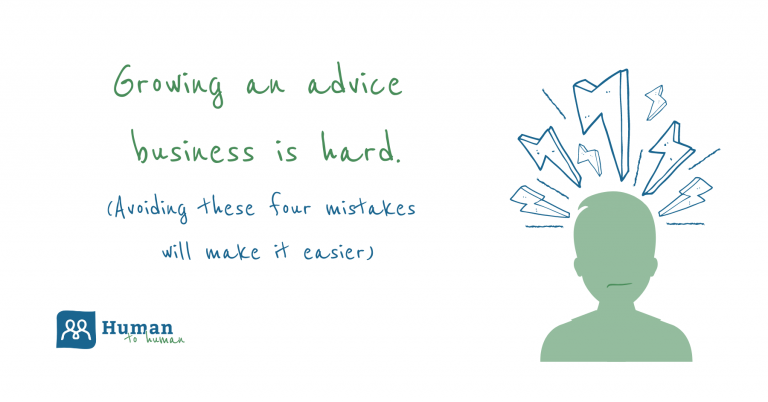There is never a shortage of ideas of how to grow a Financial Advice business. Developing referral relationships, email marketing, spreading yourself across social media – the list of options are endless and it can sometimes be paralysing for a business to know where to start and what to do next.
Having worked towards growing advice businesses for over a decade, I have witnessed hundreds chart their path to growth, mostly through trial and error. This has allowed me to spot the patterns that define the successful businesses compared to the less successful ones.
Below are some of the most common mistakes I see businesses like yours make in their marketing and business growth endeavours. I hope these help you avoid chasing the next ‘bright shiny object’ in favour of improving what you’re already doing via some small, yet meaningful changes to your client engagement experience.
Mistake #1 – Your website is hurting people’s brains
Everyone is distracted. We have more ‘devices’ and people competing for our attention than ever before, and our attention spans are plummeting by the minute.
So when we visit a website with an intention to buy something, if we don’t get what we’re looking for quickly, we’re likely to click away and find a website that’s easier to read and digest. Human brains are lazy and like to conserve as much energy as possible. Your website too is competing for attention and if you have big blocks of “jargony” text across your various pages, you’re most likely inadvertently sending website visitors to your competitors.
Your website isn’t an SOA and as important as the decision to work with an adviser is, people simply aren’t prepared to invest ten to twenty minutes digesting it all when there is a quicker alternative elsewhere.
Suggestions:
- Spend less time talking about your qualifications and experience, and more time talking about your clients, their challenges and the outcomes you can help provide for them.
- Have a mix of videos, icons and other visuals to break up and replace chunks of text.
- With any copy that sits on your website, write at a level where a twelve-year could understand it.
Mistake #2 – You’re not following up enquiries quickly enough
Think of a time when you’ve decided to buy something. You’ve created the space to do some research, you’re in the zone and you’re ready to take action. If the action you take happens to be reaching out to a business for an appointment, how would you feel if they responded 24 hours later? How about 48 or 72 hours later?
If your answer to that is ‘I would have moved onto another business by then’, you’re not alone. A Harvard Business Review study found that businesses that contacted a prospective client within 1 hour of receiving the lead were 7 times more likely to arrange a meeting with them than businesses that took 2 hours to respond. They were also 60 times more likely to arrange a meeting than companies that took 24 hours to respond. Yes, 60 times!
When it comes to responding to prospects, speed is EVERYTHING. If your business doesn’t have a process to pull out all stops and respond to new enquiries as quickly as possible, you’re most likely dampening your growth and costing your business money.
Suggestions:
- Make sure your most diligent, full-time employee is monitoring your public email inbox and knows the importance of following up new enquiries ASAP.
- Have a Calendly or other calendar-booking software linked to your website so when people are ready to act, they can lock in their first step in your process.
- Have an online chat option on your website so you can speak with prospects in real-time, in the moment when they’re ready to do something.
Mistake #3 – Few people outside your business know how good you are
Working across dozens of businesses in our industry, I can tell you that we don’t have a shortage of great financial advice businesses. But we do suffer from a shortage of great businesses publicly telling their positive story i.e. representing the happiness of their clients and the trustworthiness of their business.
Your client journey starts online and if you’re not taking control of what people find when they’re looking for a business like yours, you’re leaving your reputation in the ‘lap of the Gods’. Worse still, your lack of perceived ‘desirability’ may make an inferior competitor look more attractive. Either way, I suggest getting on the front foot here.
Suggestions:
- Google Reviews Google Reviews Google Reviews! They will put your business in front of more people, they will lead to more meetings and they will lead to more conversion. If you don’t currently have more than 50 five-star Google reviews, your business needs to put this on the top of its to-do list.
- Include these Google Reviews, or other testimonials on your website. Bonus points if you can do this via video (but text is fine if you’re just starting out).
Mistake #4 – There aren’t enough touchpoints in your client engagement process
I once did a course that taught me “The 7/11 rule”, which stated that in order to turn a prospect into a client, you needed to spend 7 hours with them, across 11 touchpoints. While I think these numbers are a little inflated, my work within some of the best businesses in our industry has demonstrated the underlying principle to be rock solid. The journey of buying is one of trust and familiarity. The more familiar you are to people, the more they will trust you and the more likely they will want to work with you.
With the explosion of online communication tools we now have at our fingertips, you can increase your number of touchpoints with relative ease. Blogging, videos, automated emails and podcasting are just a few of the highly scalable trust-building tools you now have at your disposal.
Most financial advice businesses have a client engagement process which consists of meetings, meeting confirmation emails and data collection. There’s nothing wrong with this, but you also have an opportunity to improve what happens in between meetings by harnessing some of the above tools.
Use the moments before meetings and in-between meetings to add more meaningful touchpoints, whether it be educating prospects, introducing yourself and your business properly or highlighting case studies of happy clients who your prospects can relate to.
Suggestions:
- Add video content to your website and onboarding emails to build familiarity with you and your team.
- If you have contributed to articles, podcasts or video content before, consider ways to include a link to these in the various emails you’re sending to your prospects. I would also do the same if you have a solid list of Google Reviews or testimonials.


